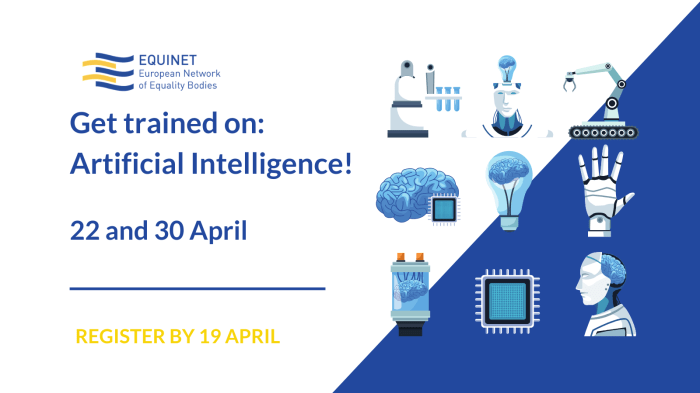How is AI trained? This process, fundamental to the operation of intelligent systems, involves a complex interplay of data, algorithms, and careful design. From collecting massive datasets to meticulously choosing the right models, training AI is a multi-faceted endeavor. We’ll explore the intricate stages of this process, highlighting the key concepts and practical applications.
Understanding the training process is crucial for anyone interested in leveraging AI. This detailed look at the mechanics behind AI training will shed light on how these powerful systems learn and adapt, from the raw data to the final, deployed model. We’ll delve into the different types of AI, the importance of data quality, and the considerations that go into evaluating and maintaining a trained model.
Introduction to AI Training

Artificial intelligence (AI) is rapidly transforming various sectors, from healthcare to finance. At its core, AI training involves equipping algorithms with the ability to learn from data, identify patterns, and make predictions or decisions without explicit programming for every scenario. This learning process is crucial for enabling AI systems to adapt and improve over time.The core concept behind AI training is to provide algorithms with massive datasets so they can discover underlying relationships and make accurate predictions or decisions on new, unseen data.
This process, while complex, is essentially about finding the optimal set of parameters within a model that minimizes errors on the training data. Different types of AI require different training approaches, reflecting the varying capabilities and complexities of the tasks they aim to perform.
Types of AI and Their Training Methods
AI systems are broadly categorized into various types, each with distinct characteristics and training needs. Machine learning (ML) algorithms are a key component of AI, enabling systems to learn from data without explicit programming. Deep learning (DL), a subset of ML, employs artificial neural networks with multiple layers to extract intricate patterns from complex data. Reinforcement learning (RL) focuses on training agents to make decisions in an environment to maximize rewards.
Natural Language Processing (NLP) systems, used for understanding and generating human language, require specialized training data and methods.
The AI Training Process: A Step-by-Step Overview
The AI training process involves several key stages. Understanding these steps provides insight into the intricacies of developing intelligent systems.
AI training is all about feeding massive datasets to algorithms, allowing them to identify patterns and make predictions. This is crucial for optimizing your online presence, and mastering SEO content strategy is key. Check out expert tips on how to improve your site’s visibility in search results at seo content strategy expert tips to master your online presence.
Ultimately, the better your content strategy, the more data AI has to learn from, leading to better results.
- Data Collection and Preparation: Gathering relevant data is paramount. This data needs meticulous cleaning, formatting, and transformation to ensure accuracy and efficiency. Data quality significantly impacts the performance of the trained model. For example, a facial recognition system trained on images with poor lighting or inaccurate labels will likely perform poorly in real-world scenarios.
- Model Selection and Design: Choosing the right model architecture is critical. Factors such as the type of data, the complexity of the task, and computational resources need careful consideration. A linear regression model might be suitable for predicting house prices, while a deep neural network might be better suited for image classification.
- Model Training: This stage involves feeding the prepared data into the chosen model. The model learns patterns and relationships within the data, adjusting its internal parameters to minimize errors. This process typically involves iterative refinement and optimization to achieve the desired level of accuracy. For instance, in training a spam filter, the model progressively learns to distinguish between legitimate and spam emails.
- Evaluation and Tuning: The trained model is assessed using a separate dataset (test data) that it hasn’t encountered during training. Metrics such as accuracy, precision, and recall are used to evaluate its performance. Based on the evaluation results, adjustments and refinements (tuning) to the model’s parameters are made to improve its accuracy on the test data.
- Deployment and Monitoring: Once the model demonstrates satisfactory performance, it is deployed into a real-world application. Continuous monitoring of the model’s performance in real-world scenarios is crucial to detect and address any issues that may arise.
Data Collection and Preparation
AI models, like any other complex system, thrive on the quality and quantity of the data they are fed. Garbage in, garbage out, is a maxim that holds true for AI training. A robust and well-prepared dataset is the cornerstone of a successful AI project, directly impacting the model’s accuracy, efficiency, and overall performance. This section dives into the crucial aspects of data collection and preparation, highlighting the importance of high-quality data and the various methods used to obtain and refine it.
Importance of High-Quality Data, How is ai trained
High-quality data is paramount for training effective AI models. Inaccurate, incomplete, or biased data can lead to flawed models that produce inaccurate predictions or perpetuate existing societal biases. The quality of data directly influences the model’s ability to learn patterns, generalize to new situations, and make reliable decisions. Models trained on high-quality data are more likely to provide accurate and unbiased results, crucial for their deployment in real-world applications.
Methods for Gathering Data
Numerous methods exist for collecting data suitable for AI training. The optimal approach depends on the specific application and the nature of the data required. Careful consideration of the desired data characteristics is essential to ensure the collected data aligns with the model’s intended purpose.
- Web Scraping: This technique involves extracting data from websites. It’s a powerful method for gathering large datasets from publicly available sources. However, ethical considerations and website terms of service must be carefully observed to avoid legal issues.
- Surveys: Structured questionnaires allow for the collection of specific information from a targeted population. Surveys can be used to gather opinions, preferences, and demographic data, providing valuable insights for training AI models in areas like customer feedback analysis or market research.
- APIs (Application Programming Interfaces): APIs provide structured access to data from various sources, including social media platforms, financial markets, and sensor networks. This method ensures data consistency and efficiency, allowing for automated data retrieval from diverse sources.
- Sensor Data: This involves gathering data from physical sensors. Examples include data from environmental monitoring stations, industrial machinery, or medical devices. This data often needs extensive pre-processing to handle noise and inconsistencies.
Data Cleaning and Pre-processing
Raw data often contains inconsistencies, errors, and irrelevant information. Before feeding data to an AI model, it needs to be meticulously cleaned and pre-processed. This stage involves handling missing values, correcting errors, and transforming data into a format suitable for the model.
- Handling Missing Values: Missing data points can significantly impact model performance. Strategies for dealing with missing values include imputation (replacing missing values with estimated ones), deletion (removing rows or columns with missing values), or using special values to indicate missingness.
- Data Transformation: Transforming data into a suitable format is crucial. This can involve scaling numerical features, encoding categorical variables, or normalizing data to improve model training and convergence. For example, converting dates to numerical values, scaling numerical features to a specific range, or converting categorical variables into numerical representations using techniques like one-hot encoding are common transformations.
- Outlier Detection and Treatment: Outliers, or extreme values, can skew the model’s learning process. Identifying and handling outliers is essential to ensure the model generalizes well to unseen data. Common methods include statistical measures or machine learning algorithms.
Comparison of Data Collection Techniques
| Technique | Pros | Cons |
|---|---|---|
| Web Scraping | Large datasets, publicly available data | Requires significant effort to structure, potential legal issues, changing website structure |
| Surveys | Targeted data collection, specific information | Can be time-consuming, limited sample size, potential for bias |
| APIs | Structured data, efficient retrieval, diverse sources | Requires API access, potential data limitations, need for authentication |
| Sensor Data | Real-time data, continuous monitoring | Noise, inconsistencies, complex pre-processing |
Model Selection and Architecture
Choosing the right AI model is crucial for success in any machine learning project. It’s not just about selecting a popular algorithm; careful consideration of the task’s specific requirements and the model’s strengths and weaknesses is paramount. This section delves into the diverse landscape of AI models, highlighting key factors for selection and showcasing various architectures and their practical applications.The selection of an AI model is not a one-size-fits-all process.
Different models excel in different domains and tasks. Factors like the size and nature of the dataset, the complexity of the task, and the desired level of accuracy all play a role in the model selection process. Understanding the strengths and weaknesses of various models is essential for making informed decisions.
Available AI Models
Various AI models are available for different tasks. Supervised learning models, like linear regression and support vector machines, are used for tasks where input-output relationships are known. Unsupervised learning models, including clustering algorithms and dimensionality reduction techniques, are useful when the goal is to discover patterns or structures within the data. Reinforcement learning models, on the other hand, are designed for learning through trial and error in dynamic environments.
Deep learning models, such as neural networks, are powerful tools for complex tasks, particularly when dealing with large datasets.
Factors for Model Selection
Several factors influence the choice of an AI model. The size and characteristics of the dataset are crucial. A large, complex dataset might necessitate a deep learning model, while a smaller dataset might be better suited to a simpler model. The desired level of accuracy and the computational resources available are also important considerations. The task itself plays a vital role; a classification task may require a different model than a regression task.
Model Architectures and Applications
Different AI models possess unique architectures that affect their performance and applicability. Linear regression, a simple supervised learning model, uses a linear equation to predict an output based on input variables. Support Vector Machines (SVMs) find optimal hyperplanes to separate data points, demonstrating strong performance in classification tasks. Decision trees break down data into smaller subsets based on decision rules, offering a clear and interpretable approach to problem-solving.
Neural networks, with their interconnected layers of nodes, are capable of handling complex patterns and are used in tasks like image recognition and natural language processing.
Comparison of AI Models
| Model | Strengths | Weaknesses |
|---|---|---|
| Linear Regression | Simple, interpretable, fast training | Limited to linear relationships, less accurate for complex data |
| Support Vector Machines (SVM) | Effective for high-dimensional data, good generalization | Can be computationally expensive for very large datasets, may not perform well with non-linear data |
| Decision Trees | Easy to understand, handles both numerical and categorical data | Prone to overfitting, less accurate than more complex models |
| Neural Networks (Deep Learning) | High accuracy for complex tasks, adaptable to various data types | Complex architecture, require large datasets and significant computational resources, can be difficult to interpret |
Training Algorithms and Techniques
AI training hinges on the algorithms used to adjust the model’s parameters. These algorithms are the heart of the learning process, determining how the model interacts with the data and refines its understanding. Different algorithms excel at different types of tasks and data, so choosing the right one is crucial for success. Understanding the underlying principles and comparing different approaches is key to effective AI model development.
Common AI Training Algorithms
Various algorithms are employed in AI training, each with its strengths and weaknesses. Gradient descent is a foundational technique used in many algorithms, aiming to minimize the difference between predicted and actual outputs. Other popular methods include stochastic gradient descent (SGD), Adam, and RMSprop, each optimizing the model’s parameters through iterative adjustments. These algorithms play a critical role in the model’s ability to learn from data and make accurate predictions.
Comparison of Training Approaches
Different learning approaches cater to distinct types of data and tasks. Supervised learning, for instance, relies on labeled data, where the model learns to map inputs to outputs based on examples. Unsupervised learning, on the other hand, works with unlabeled data, aiming to discover hidden patterns and structures within the information. Reinforcement learning, inspired by reward-based learning in the real world, involves an agent interacting with an environment and learning optimal actions to maximize cumulative rewards.
Understanding the distinctions between these approaches is vital in selecting the appropriate method for a specific AI application.
Hyperparameter Tuning
Hyperparameter tuning is a critical step in optimizing model performance. Hyperparameters are settings that control the learning process, such as the learning rate in gradient descent. Finding the optimal values for these hyperparameters can significantly impact the model’s accuracy and efficiency. Techniques like grid search and random search systematically explore different combinations of hyperparameter values to identify the best configuration.
This process ensures the model is performing at its best potential.
Detailed Description of Stochastic Gradient Descent (SGD)
Stochastic Gradient Descent (SGD) is an iterative optimization algorithm widely used in training machine learning models. It’s particularly effective for large datasets due to its efficiency. The algorithm works by calculating the gradient of the loss function with respect to the model’s parameters for a single data point or a small batch of data points (hence “stochastic”). The parameters are then updated in the direction that minimizes the loss.
This process is repeated iteratively until the model converges to a satisfactory solution.
- Initialization: The model’s parameters are initialized randomly.
- Iteration: The algorithm iterates through the training data, one batch or data point at a time.
- Gradient Calculation: The gradient of the loss function with respect to the parameters is calculated for the current batch or data point.
- Parameter Update: The parameters are updated using the calculated gradient and a learning rate to adjust the model.
- Convergence: The process repeats until the model’s performance on a validation set (a separate dataset not used for training) stabilizes or reaches a predetermined number of iterations.
Considerations for SGD
Several factors need consideration when using SGD. The learning rate is a crucial hyperparameter, influencing the step size during parameter updates. A high learning rate can lead to oscillations, while a low learning rate can result in slow convergence. The batch size, which dictates how many data points are used to compute the gradient, also impacts the algorithm’s efficiency and stability.
Appropriate tuning of these parameters is essential for optimal model performance.
Evaluation Metrics and Performance
AI models, like any other system, need to be rigorously evaluated to ensure they perform as expected and meet the desired objectives. Evaluation goes beyond simply checking if the model works; it involves quantifying its performance, identifying strengths and weaknesses, and ultimately determining its suitability for the intended task. This crucial step allows for adjustments and improvements, leading to more accurate and effective AI solutions.
Significance of Evaluating AI Model Performance
Evaluating AI model performance is paramount for several reasons. Firstly, it allows for a precise assessment of the model’s accuracy and effectiveness in relation to the specific task. This measurement is essential to understand the model’s capabilities and limitations. Secondly, it provides insights into potential biases or errors within the model’s predictions, enabling corrective actions and improvements in the training process.
Finally, evaluating performance facilitates comparisons between different models or approaches, helping to select the most suitable one for a given application.
Different Metrics for Assessing Model Accuracy and Effectiveness
Various metrics are employed to quantify the accuracy and effectiveness of AI models. These metrics provide a numerical representation of the model’s performance, allowing for comparisons and analysis. Understanding these metrics is critical to drawing meaningful conclusions about the model’s capabilities.
- Accuracy: This fundamental metric represents the percentage of correctly classified instances. A high accuracy score suggests a model that correctly predicts the outcome most of the time. For example, a medical diagnosis AI with 95% accuracy correctly identifies a disease in 95 out of 100 cases.
- Precision: Precision focuses on the accuracy of positive predictions. It measures the proportion of correctly predicted positive instances out of all instances predicted as positive. In a spam filter, high precision indicates that the filter correctly identifies spam emails without misclassifying legitimate emails as spam.
- Recall: Recall measures the proportion of correctly predicted positive instances out of all actual positive instances. In a fraud detection system, high recall ensures that the system catches most fraudulent transactions, even if it flags some legitimate transactions as fraudulent.
- F1-Score: The F1-score is a harmonic mean of precision and recall, providing a balanced measure of both aspects. It is particularly useful when precision and recall are equally important. A high F1-score suggests a model with good accuracy in both aspects. For example, a model with a high F1-score in identifying cancerous cells would correctly identify most cancerous cells and minimize false negatives.
- AUC (Area Under the ROC Curve): AUC is a measure of separability between classes. It represents the probability that a randomly chosen positive instance will be ranked higher than a randomly chosen negative instance. A higher AUC indicates better model performance.
Validation and Testing of Trained AI Models
Validating and testing AI models is a crucial step in ensuring their reliability and generalizability. A well-designed validation process involves splitting the dataset into training, validation, and testing sets. The training set is used to train the model, the validation set is used to tune the model’s parameters, and the testing set is used to evaluate the model’s performance on unseen data.
This approach helps to prevent overfitting, where the model performs exceptionally well on the training data but poorly on new, unseen data.
Evaluation Metrics Table
| Metric | Description | Interpretation | Example |
|---|---|---|---|
| Accuracy | Percentage of correct predictions | Higher is better | 90% accuracy in image classification |
| Precision | Proportion of true positives among predicted positives | Higher is better, especially when false positives are costly | 95% precision in identifying spam emails |
| Recall | Proportion of true positives among actual positives | Higher is better, especially when false negatives are costly | 98% recall in detecting fraudulent transactions |
| F1-Score | Harmonic mean of precision and recall | Higher is better | 85% F1-score in disease diagnosis |
| AUC | Area under the ROC curve | Higher is better, indicates better separation between classes | 0.95 AUC in a medical diagnosis model |
Deployment and Maintenance: How Is Ai Trained
Deploying a trained AI model into a production environment is a crucial step, but it’s just the beginning. Continuous monitoring, maintenance, and potential retraining are vital for ensuring the model remains accurate and effective over time. Ignoring these aspects can lead to decreased performance, unreliable results, and even financial losses in applications where AI is critical.
Deployment Process
The deployment process involves integrating the trained model into a production system. This often involves creating APIs (Application Programming Interfaces) that allow other applications to interact with the model. A crucial aspect is choosing the appropriate deployment platform and infrastructure. Cloud platforms offer scalability and ease of management, while on-premises solutions may be more suitable for specific security or regulatory needs.
Proper documentation and version control are essential for future maintenance and updates.
Model Monitoring and Maintenance
Ongoing monitoring is critical to identify potential issues in real-time. Monitoring tools track key metrics like accuracy, latency, and resource consumption. Regularly analyzing these metrics allows for proactive identification of deteriorating performance and enables swift intervention. Alert systems can notify administrators of any deviations from predefined thresholds, enabling rapid response and preventing further damage. Robust logging mechanisms are essential for tracing errors and understanding the context behind model behavior.
AI training is fascinating, isn’t it? It’s all about feeding massive datasets to algorithms, allowing them to learn patterns and make predictions. But sometimes, even with great AI, your website traffic isn’t translating into sales. Maybe you need to check out 5 reasons your site traffic isn’t converting to sales to see if there are any common pitfalls you might be overlooking.
Ultimately, understanding these conversion issues is key to any successful AI project.
Retraining Necessity
Model retraining is necessary as the underlying data distribution shifts over time. This phenomenon, known as data drift, can occur due to various factors, including changes in customer behavior, evolving market trends, or shifts in data sources. If left unaddressed, data drift can lead to a significant decline in model performance. For example, a fraud detection model trained on historical data might become less accurate if new fraud schemes emerge.
Continuous Improvement
Continuous improvement is vital for maintaining model performance and accuracy. Regularly evaluating and analyzing the model’s predictions against real-world outcomes is essential. This feedback loop allows for identification of areas for improvement and the implementation of updates. Regular retraining with new data, or fine-tuning existing models, can significantly enhance performance. Furthermore, incorporating user feedback and real-world experience can lead to more accurate and relevant models.
Ethical Considerations in AI Training

AI training, while offering remarkable potential, raises crucial ethical concerns. As AI systems become increasingly sophisticated, their impact on society expands, demanding careful consideration of the values and principles they embody. Ignoring these ethical implications could lead to unintended consequences and perpetuate existing societal inequalities.The training data used to build AI models plays a critical role in shaping the AI’s behavior and decision-making processes.
Biases present in this data can be inadvertently amplified and perpetuated by the AI, leading to unfair or discriminatory outcomes. Furthermore, the lack of transparency in how these models arrive at their conclusions can make it challenging to identify and rectify these issues. Understanding and addressing these ethical considerations is paramount for responsible AI development.
Potential Biases in Training Data
Training data often reflects existing societal biases, which can be amplified and perpetuated by AI systems. For example, if a facial recognition system is trained primarily on images of people of a specific ethnicity, it may perform poorly or inaccurately identify people from other ethnic groups. Similarly, recruitment tools trained on historical data that reflects gender bias may perpetuate these inequalities in hiring practices.
Mitigation Strategies for Bias
Addressing biases in training data requires a multifaceted approach. Diverse and representative datasets are crucial. Active efforts should be made to ensure that the training data reflects the diversity of the population it will serve. Techniques like data augmentation and synthetic data generation can help to increase the representation of underrepresented groups. Furthermore, careful evaluation and auditing of the training data are necessary to identify and eliminate any overt biases.
AI training is all about feeding massive datasets to algorithms, letting them learn patterns and relationships. This process, like any other, requires a skilled hand to direct. A key component in this process is ensuring your cybersecurity strategy is sound, which is where effective CISOs need to balance their technical and operational expertise. This crucial balance is examined in detail at effective cisos technical vs operational.
Ultimately, the more data and the better the algorithms, the better the AI performs, whether it’s recognizing images or predicting trends.
Fairness and Transparency in AI Systems
Fairness in AI systems means ensuring that the system treats all individuals and groups equitably, without discrimination or bias. Transparency, in this context, refers to the ability to understand how an AI system arrives at its decisions. This is crucial for accountability and trust. A lack of fairness or transparency can lead to societal harms, impacting individuals’ access to resources and opportunities.
For instance, an AI system used to assess loan applications that unfairly discriminates against certain demographics could have severe financial consequences for those individuals.
Ethical Concerns and Best Practices in AI Training
| Ethical Concern | Best Practice |
|---|---|
| Bias in Training Data | Collect diverse and representative data; Use data augmentation and synthetic data; Implement bias detection and mitigation techniques; Regularly audit data for biases. |
| Lack of Transparency | Develop explainable AI (XAI) models; Document data collection and preprocessing steps; Make decision-making processes transparent and auditable; Clearly communicate limitations and potential biases of the AI system. |
| Unintended Consequences | Conduct thorough impact assessments; Engage with stakeholders to understand potential societal impacts; Develop ethical guidelines and frameworks for AI development; Establish mechanisms for monitoring and evaluation of AI systems. |
| Accountability and Responsibility | Establish clear lines of responsibility for AI systems; Develop mechanisms for addressing complaints and errors; Foster ongoing dialogue about ethical implications; Promote education and awareness about AI ethics. |
Case Studies of AI Training
AI training projects are not theoretical exercises; they are real-world applications with tangible impacts. Understanding successful implementations, along with the challenges they overcame, provides valuable insights for future endeavors. This section delves into case studies across various domains, highlighting the power and potential pitfalls of AI training.
Successful AI Training Projects in Healthcare
AI is revolutionizing healthcare, from diagnosis to drug discovery. One notable example involves the development of AI models for early detection of diabetic retinopathy. These models, trained on vast datasets of retinal images, can identify subtle signs of the disease with a high degree of accuracy, enabling earlier intervention and preventing vision loss. The challenge in this project involved the variability in image quality and the need for robust data augmentation techniques to train the model effectively.
This was addressed through standardization protocols for image acquisition and data augmentation techniques that mimicked variations in real-world images. The impact on the healthcare industry is significant, leading to improved patient outcomes and potentially reducing healthcare costs associated with late-stage treatment.
AI in Finance: Fraud Detection
AI is a powerful tool for fraud detection in financial institutions. Banks and credit card companies utilize AI models trained on massive transaction data to identify suspicious patterns and activities. A successful project focused on credit card fraud detection involved training a deep learning model on historical transaction data, including features like location, time of day, and transaction amount.
Challenges in this project included the need to maintain a balance between accuracy and false positives. Sophisticated techniques were employed to adjust the model’s sensitivity and minimize the risk of legitimate transactions being flagged as fraudulent. The impact of this AI training is significant in reducing fraud losses and enhancing customer trust.
Real-World Applications of AI Training
- Automated Customer Service Chatbots: These chatbots, trained on vast amounts of customer interaction data, can handle routine inquiries and provide instant support. The training data includes historical conversations, FAQs, and user feedback, allowing the chatbot to learn and adapt to different customer needs. Challenges include handling complex queries that require human intervention and maintaining a consistent, helpful tone.
- Personalized Recommendations in E-commerce: AI algorithms trained on user browsing history, purchase patterns, and product information generate personalized recommendations. This enhances user experience and drives sales. Challenges include maintaining data privacy and ensuring recommendations remain relevant over time.
- Predictive Maintenance in Manufacturing: AI models analyze sensor data from machines to predict potential failures and schedule maintenance proactively. Training involves historical maintenance records, sensor readings, and machine performance data. Challenges include handling complex relationships between various factors and ensuring model robustness under changing conditions.
- Image Recognition for Object Detection: AI models trained on massive datasets of images can identify and classify various objects in images. This technology is used in self-driving cars, medical imaging, and security applications. Challenges involve handling variations in lighting, object size, and image quality.
Data Quality and AI Training
The success of AI training heavily depends on the quality of the training data. Garbage in, garbage out, is a common adage in the field. High-quality data involves ensuring data accuracy, completeness, consistency, and relevance to the task at hand. This often requires significant preprocessing steps to handle missing values, outliers, and inconsistencies. In addition, data bias and representation issues need careful attention to prevent the model from exhibiting unfair or discriminatory behavior.
Last Word
In conclusion, training AI is a journey that involves careful data preparation, model selection, and algorithm tuning. This process is not a one-size-fits-all approach, but rather an iterative process requiring adaptation and optimization. Ethical considerations and continuous evaluation are essential to ensure the responsible and effective use of AI. Ultimately, understanding how AI is trained empowers us to harness its potential while mitigating its risks.









